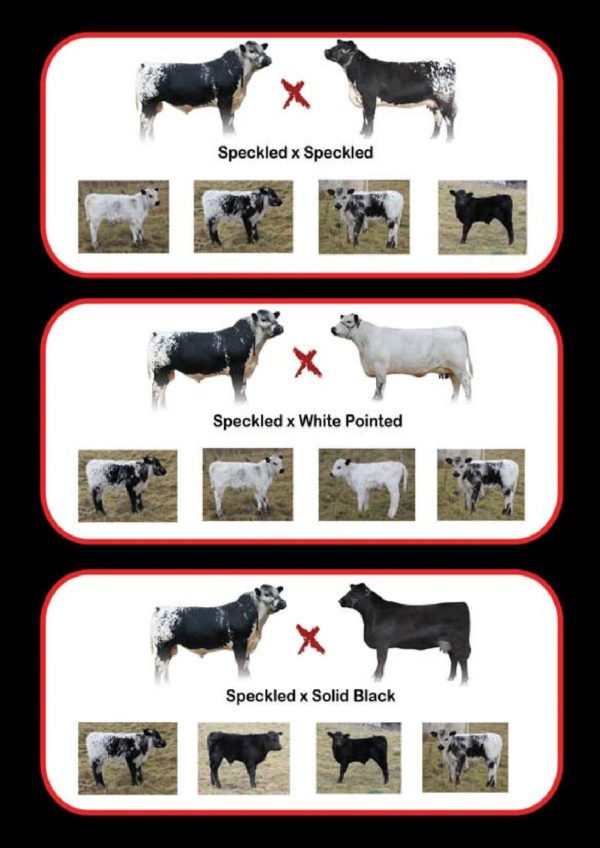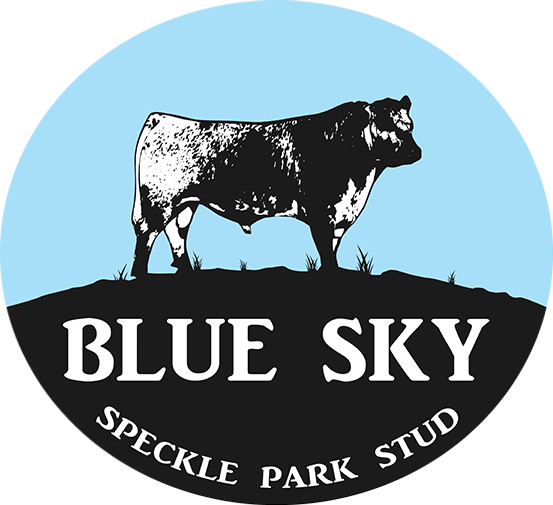Speckle Park Genetics/DNA
Speckle Park International, the governing body for Australian and New Zealand Breeders, is a proud leader in the adoption of genetic testing to better inform breeders about their animals, and improve the integrity of our herd book. Animals born after January 1st 2018 are required to have results for the series of genetic tests prior to registration being granted. (Animals that are to be donors also require these tests before they are able to be registered as a donor)
More recently in July 2023 SPI introduced a major upgrade to Speckle Park Breedplan evaluation with Single-step Breedplan which uses SNP data along side Pedigree and Performance data to calculate Breedplan EBVs and accuracy “in one step”. This applies to all traits in a multi-trait model combining birth, growth, fertility and carcase traits. As such, SNP data provides additional information in these calculations by accounting for the true genomic relationships among animals and how the SNP information relates to the performance records for each trait in the analysis. The evaluation takes account of each animals actual genetic relationship with all other genotyped animals including those in the reference population. The reference population is the set of Speckle Park animals that have genotypes (SNP data) and phenotypes (performance records) for each particular trait.
SNP for Speckle Park Animals
- 50K SNP DNA profile
- Parent verification to sire and dam
- Myostatin gene
- Red coat colour gene
- Poll testing
Here is additional information about these tests:
Red Gene Test
Speckle Park cattle are black and white, however the red gene is known to be present in the Speckle Park population. Whilst an animal may phenotypically appear black and white, they can carry the red allele and pass it along to their progeny. To determine whether an animal is a red gene carrier, breeders conduct the red gene test when DNA testing their cattle on the Speckle Park International Standard DNA Bundle. The crossing of two red gene carriers results in a 25% chance of breeding a red calf – Red cattle cannot be registered in the Speckle Park International herd book.
Poll Testing
Cattle will phenotypically display as either horned, scurred or polled. The animals horn status is determined by two alleles. Poll is dominant whilst the presence of horns is recessive in cattle. An animal can be phenotypically polled whilst still carrying a horn gene. Speckle Park cattle are a polled animal, so while homozygous and heterozygous polled animals can be registered with Speckle Park International, horned animals may not. As stud breeders of Speckle Park cattle, all herd book registered cattle need to be DNA poll tested to determine what genes will be passed along to future generations. The three genetic poll statuses are:
- Homozygous Polled (PP) — animal carries two copies of the poll gene and will appear polled.
- Heterozygous Polled (PH) — animal carries one copy of the poll gene and one copy of the horn gene and may appear polled or scurred.
- Horned (HH) — animal carries two copies of the horn gene and will appear horned – These animals are not permitted for registration with Speckle Park International.
Myostatin Gene Test
Myostatin is an essential protein for the regulation of muscle mass. Mutations to the myostatin gene can result in a multitude of changes to the muscles function, which can include “double muscling”, whereby the muscle growth and development isn’t regulated by the body. Speckle Park cattle are known to be potential carriers of the nt821 myostatin gene and breeders are required to test for presence of myostatin mutations to prevent the proliferation of the mutation within the breed. Myostatin affected animals (carry two copies of the mutation) are unable to be registered in the Speckle Park herd book.
Parent Verification
All herd book recorded animals born after January 1, 2018, are required to be DNA parent verified to both their sire and dam. This allows Speckle Park International to maintain the integrity of the herd book. Calves are not registered until parent verification is complete.
Leptin Test
A reasonably new test, leptin is believed to be an indicator for growth and feed efficiency in cattle and overall carcass quality. While Leptin testing is not compulsory for registration of animals, it is included in the Speckle Park International Standard DNA Bundle so breeders can make more informed breeding decisions resulting in cattle that are better suited to the commercial production’ of beef.
*So, if you want peace of mind that what you are purchasing is Speckle Park through and through not just skin deep, buy registered animals.
Colour Patterns of Speckle Park Breed
Speckle Park are genetically black with varying amounts of white in specific patterns. The speckle pattern is preferred but the other patterns are very much accepted within the breed.
- The speckle pattern is predominantly black with a white top line and underline, with speckled hips, and sometimes shoulders, and with a black or black roan face.
- The Leopard pattern shows more white than the speckle pattern. On the leopard pattern the black sides of the speckle pattern are broken into a series of black spots. The number and size of the spots varies greatly from animal to animal. Some leopards have predominantly white sides with only a few black spots on their sides. The leopard also has a white top line and underline. In genetic terms, the speckle pattern and the leopard pattern appear to be the same with the difference being only in the number of spots.
- The third colour pattern is the white with black points. Animals with this pattern are predominantly white on the body and face but always have black points, that is the ears, nose, skin around the eyes, muzzle and the Lower portions of the legs including the hooves are black. These same points are black on all of the patterns.
- Some Speckle Park animals are solid black.
Colour Pattern Breeding Results
Below are six combinations of the Speckle Park patterns for breeding. For these purposes speckle and leopard are in effect genetically the same with only a variation in the frequency of spots. This should be used as a guide only.


